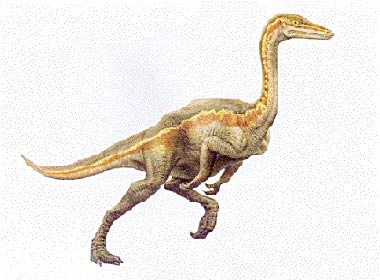Ornithomimus velox - Cretaceous Dinosaurs
Homepage > Cretaceous Dinosaurs - Ornithomimus velox
(or-nith-oh-my-muss-)
"bird mimic"
Describer Marsh, 1890
Also Known As ?Dromiceiomimus
Type of Species velox
Order Saurischia
SubOrder Theropoda
InfraOrder --
Micro-Order --
Family Ornithomimidae
Size 12 feet (3.7 meters) long
Period Late Cretaceous, 65 million years ago
Fossilsite Colorado, Utah, Montana, Wyoming, USA; Alberta,
Canada
Diet Carnivore
Ornithomimus lived during the Late Cretaceous Period, about 65 million years ago in areas of the US and Alberta, Canada. Ornithomimus belongs to a family of dinosaurs called the ornithomimids. It was ostrich-like which toothless bills, graceful bodies and clawed feet. It is believed that Ornithomimus may have been one of the fastest animals alive in its time. Ornithomimus had powerful leg muscles that may have made possible for this dinosaur to reach speeds of up to 43 miles per hour over short distances, this is the speed that an ostrich reaches today. Ornithomimus speed may have been this dinosaurs best defense against predators.
Ornithomimus was once considered to have been an omnivore, a dinosaur that ate all foods. But not everyone agrees with this, some scientist believe it was a herbivore, living only on plant diet. They believe that in order for Ornithomimus to eat meat, it would have needed teeth which it did not have. It had long arms, this arms may have been used to secure its prey and possibly reach up into trees to pull small branches for it to consume vegetation. Ornithomimus mouth did not contain teeth, instead, it used its scissor like bill to chop its food into smaller and smaller pieces, that he may be able to swallow.

Discovery
The first fossilized Ornithomimus bones were found in the late 1880s,
in Colorado and Montana. None of these specimens were complete, but these
findings were enough for the American paleontologists Othniel Marsh to
recognize that a new dinosaur species had been discovered.